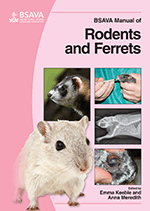
Full text loading...

As a result of the increasing numbers of guinea pigs, chinchillas and other small rodents being kept as private pets, dental disease is being observed more frequently in veterinary clinics. Incidence of oral cavity disease is approximately 30-80%. It varies both between species and within a species with age. A wide range of local and systemic conditions that affect the mouth have been described in rodents, including hereditary, infectious and metabolic diseases, trauma, electrical accidents and neoplasia. The diagnosis of dental disease in small mammals is complicated due to the anatomical structure of the oral cavity and special mechanics of the jaw movements. Being able to recognize variable anatomical and physiological variations, to understand disease pathophysiology and assess even minor changes will help in optimal treatment of many commonly seen conditions. This chapter considers Anatomy and physiology; Clinical signs; Oral cavity examination; Dental disease; Therapy and Prevention.
Rodents: dentistry, Page 1 of 1
< Previous page | Next page > /docserver/preview/fulltext/10.22233/9781905319565/9781905319565.8-1.gif

Full text loading...














